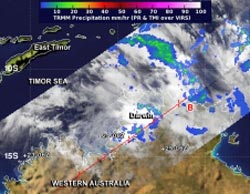NASA Sees Tropical Cyclone Alessia Make Landfall Near Darwin

NASA's TRMM satellite passed over Tropical Storm Alessia on November 24 at 1325 UTC/8:25 a.m. EST and identified mostly light rain from the system (blue) with a small area (green) of moderate rainfall. <br>Image Credit: NASA/SSAI, Hal Pierce<br>
The final warning on the tropical storm was issued on November 24 from the Joint Typhoon Warning Center at 0900 UTC/4 a.m. EST. At that time, Tropical Cyclone Alessia was located near 13.8 south latitude and 129.0 east longitude, about 136 nautical miles/156.5 miles/252 km southwest of Darwin, Australia. Alessia was moving to the east at 15 knots/17.2 mph/27.7 kph and had maximum sustained winds near 35 knots/40 mph/62 kph at the time.
NASA's Tropical Rainfall Measuring Mission or TRMM satellite passed over Tropical Storm Alessia on November 24 at 1325 UTC/8:25 a.m. EST and identified mostly light rain from the system with a small area of moderate rainfall, falling at a rate of 1.18 inch/30 mm per hour.
Cyclone Alessia crossed Australia's Northern Territory coast and made landfall south of Darwin during the night-time hours and quickly dissipated.
The Australian Bureau of Meteorology reported that the Upper Adelaide River, just north of where Alessia made landfall, received tropical-storm-force winds and received about 54 millimeters of rain. No damages were reported.
Text credit: Rob Gutro
NASA's Goddard Space Flight Center
Media Contact
All latest news from the category: Earth Sciences
Earth Sciences (also referred to as Geosciences), which deals with basic issues surrounding our planet, plays a vital role in the area of energy and raw materials supply.
Earth Sciences comprises subjects such as geology, geography, geological informatics, paleontology, mineralogy, petrography, crystallography, geophysics, geodesy, glaciology, cartography, photogrammetry, meteorology and seismology, early-warning systems, earthquake research and polar research.
Newest articles

Webb captures top of iconic horsehead nebula in unprecedented detail
NASA’s James Webb Space Telescope has captured the sharpest infrared images to date of a zoomed-in portion of one of the most distinctive objects in our skies, the Horsehead Nebula….

Cost-effective, high-capacity, and cyclable lithium-ion battery cathodes
Charge-recharge cycling of lithium-superrich iron oxide, a cost-effective and high-capacity cathode for new-generation lithium-ion batteries, can be greatly improved by doping with readily available mineral elements. The energy capacity and…

Novel genetic plant regeneration approach
…without the application of phytohormones. Researchers develop a novel plant regeneration approach by modulating the expression of genes that control plant cell differentiation. For ages now, plants have been the…





















